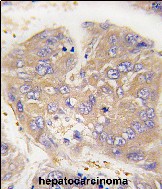Dtnbp1 Antibody (N-term)
Purified Rabbit Polyclonal Antibody (Pab)
- 产品详情
- 实验流程
- 背景知识
Application
| WB, IHC-P, E |
|---|---|
| Primary Accession | Q91WZ8 |
| Reactivity | Human, Mouse |
| Host | Rabbit |
| Clonality | Polyclonal |
| Isotype | Rabbit IgG |
| Calculated MW | 39651 Da |
| Antigen Region | 8-38 aa |
| Gene ID | 94245 |
|---|---|
| Other Names | Dysbindin, Biogenesis of lysosome-related organelles complex 1 subunit 8, BLOC-1 subunit 8, Dysbindin-1, Dystrobrevin-binding protein 1, Hermansky-Pudlak syndrome 7 protein homolog, HPS7 protein homolog, Dtnbp1, Bloc1s8, Sdy |
| Target/Specificity | This Dtnbp1 antibody is generated from rabbits immunized with a KLH conjugated synthetic peptide between 8-38 amino acids from the N-terminal region of human Dtnbp1. |
| Dilution | WB~~1:1000 IHC-P~~1:100~500 E~~Use at an assay dependent concentration. |
| Format | Purified monoclonal antibody supplied in PBS with 0.09% (W/V) sodium azide. This antibody is purified through a protein G column, followed by dialysis against PBS. |
| Storage | Maintain refrigerated at 2-8°C for up to 2 weeks. For long term storage store at -20°C in small aliquots to prevent freeze-thaw cycles. |
| Precautions | Dtnbp1 Antibody (N-term) is for research use only and not for use in diagnostic or therapeutic procedures. |
| Name | Dtnbp1 |
|---|---|
| Synonyms | Bloc1s8, Sdy |
| Function | Component of the BLOC-1 complex, a complex that is required for normal biogenesis of lysosome-related organelles (LRO), such as platelet dense granules and melanosomes. In concert with the AP-3 complex, the BLOC-1 complex is required to target membrane protein cargos into vesicles assembled at cell bodies for delivery into neurites and nerve terminals. The BLOC-1 complex, in association with SNARE proteins, is also proposed to be involved in neurite extension. Associates with the BLOC-2 complex to facilitate the transport of TYRP1 independent of AP-3 function. Plays a role in synaptic vesicle trafficking and in neurotransmitter release. Plays a role in the regulation of cell surface exposure of DRD2. May play a role in actin cytoskeleton reorganization and neurite outgrowth. May modulate MAPK8 phosphorylation. Appears to promote neuronal transmission and viability through regulating the expression of SNAP25 and SYN1, modulating PI3- kinase-Akt signaling and influencing glutamatergic release. Regulates the expression of SYN1 through binding to its promoter. Modulates prefrontal cortical activity via the dopamine/D2 pathway. |
| Cellular Location | [Isoform 1]: Cytoplasm. Cytoplasmic vesicle membrane; Peripheral membrane protein; Cytoplasmic side. Endosome membrane; Peripheral membrane protein; Cytoplasmic side. Melanosome membrane; Peripheral membrane protein; Cytoplasmic side. Postsynaptic density. Endoplasmic reticulum. Nucleus. Note=Mainly cytoplasmic but shuttles between the cytoplasm and nucleus. Exported out of the nucleus via its NES in a XPO1-dependent manner. Nuclear localization is required for regulation of the expression of genes such as SYN1. Detected in neuron cell bodies, axons and dendrites. Mainly located to the postsynaptic density. Detected at tubulovesicular elements in the vicinity of the Golgi apparatus and of melanosomes Occasionally detected at the membrane of pigmented melanosomes in cultured melanoma cells (By similarity). The BLOC-1 complex associates with the BLOC-2 complex in early endosome-associated tubules Associated with the AP-3 complex at presynaptic terminals |
| Tissue Location | Detected in brain, in hippocampus and dentate gyrus neurons. Detected at axon bundles and axon terminals, notably in the cerebellum and hippocampus. Detected in neuropil in hippocampus, lateral septum, basal ganglia and substantia nigra. Highly expressed in pyramidal cells of hippocampus CA2 and CA3. Detected at the heart and skeletal muscle sarcolemma (at protein level). Ubiquitously expressed The highest expression is observed in testis, liver, kidney, brain, heart and lung. Expressed at lower levels in stomach and small intestine. |
For Research Use Only. Not For Use In Diagnostic Procedures.
Provided below are standard protocols that you may find useful for product applications.
BACKGROUND
Dtnbp1 may play a role in organelle biogenesis associated with melanosomes, platelet dense granules, and lysosomes. A similar protein in mouse is a component of a protein complex termed biogenesis of lysosome-related organelles complex 1 (BLOC-1), and binds to alpha- and beta-dystrobrevins, which are components of the dystrophin-associated protein complex (DPC). Mutations are associated with Hermansky-Pudlak syndrome type 7. This protein may also be associated with schizophrenia.
REFERENCES
Benson M.A.,J. Biol. Chem. 276:24232-24241(2001).
Li W., Nat. Genet. 35:84-89(2003).
Talbot K., Hum. Mol. Genet. 15:3041-3054(2006).
终于等到您。ABCEPTA(百远生物)抗体产品。
点击下方“我要评价 ”按钮提交您的反馈信息,您的反馈和评价是我们最宝贵的财富之一,
我们将在1-3个工作日内处理您的反馈信息。
如有疑问,联系:0512-88856768 tech-china@abcepta.com.























 癌症的基本特征包括细胞增殖、血管生成、迁移、凋亡逃避机制和细胞永生等。找到癌症发生过程中这些通路的关键标记物和对应的抗体用于检测至关重要。
癌症的基本特征包括细胞增殖、血管生成、迁移、凋亡逃避机制和细胞永生等。找到癌症发生过程中这些通路的关键标记物和对应的抗体用于检测至关重要。 为您推荐一个泛素化位点预测神器——泛素化分析工具,可以为您的蛋白的泛素化位点作出预测和评分。
为您推荐一个泛素化位点预测神器——泛素化分析工具,可以为您的蛋白的泛素化位点作出预测和评分。 细胞自噬受体图形绘图工具为你的蛋白的细胞受体结合位点作出预测和评分,识别结合到自噬通路中的蛋白是非常重要的,便于让我们理解自噬在正常生理、病理过程中的作用,如发育、细胞分化、神经退化性疾病、压力条件下、感染和癌症。
细胞自噬受体图形绘图工具为你的蛋白的细胞受体结合位点作出预测和评分,识别结合到自噬通路中的蛋白是非常重要的,便于让我们理解自噬在正常生理、病理过程中的作用,如发育、细胞分化、神经退化性疾病、压力条件下、感染和癌症。







